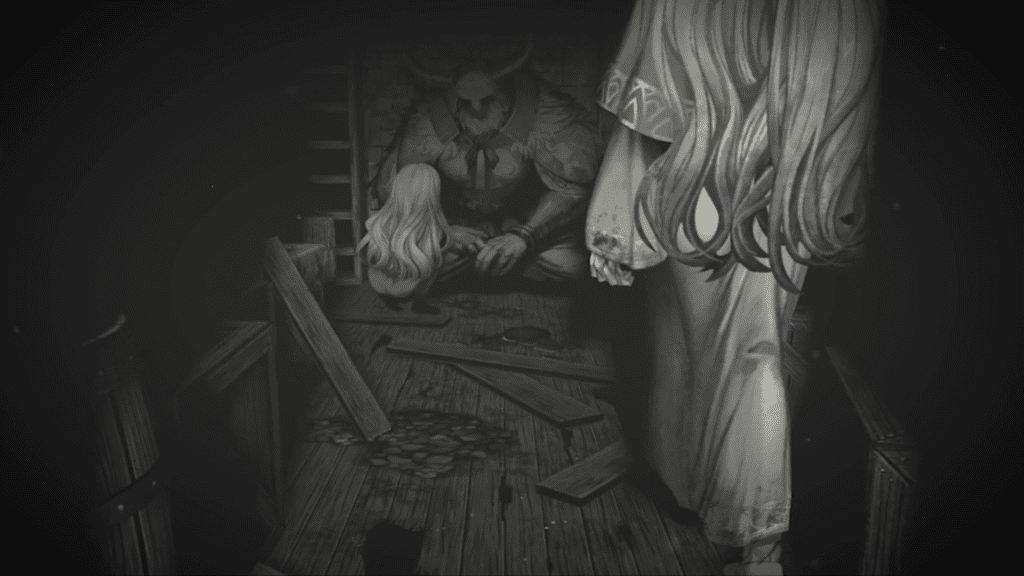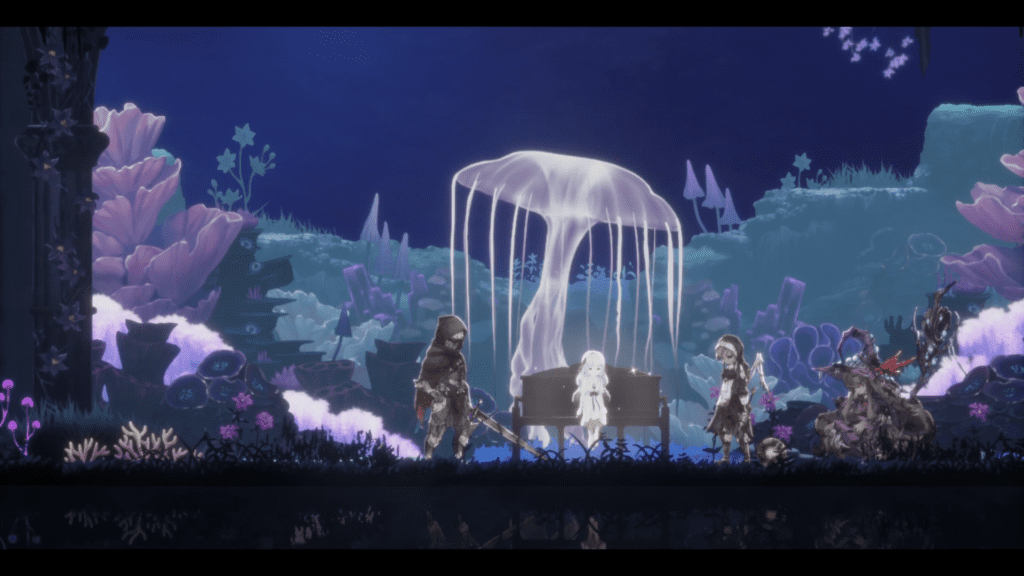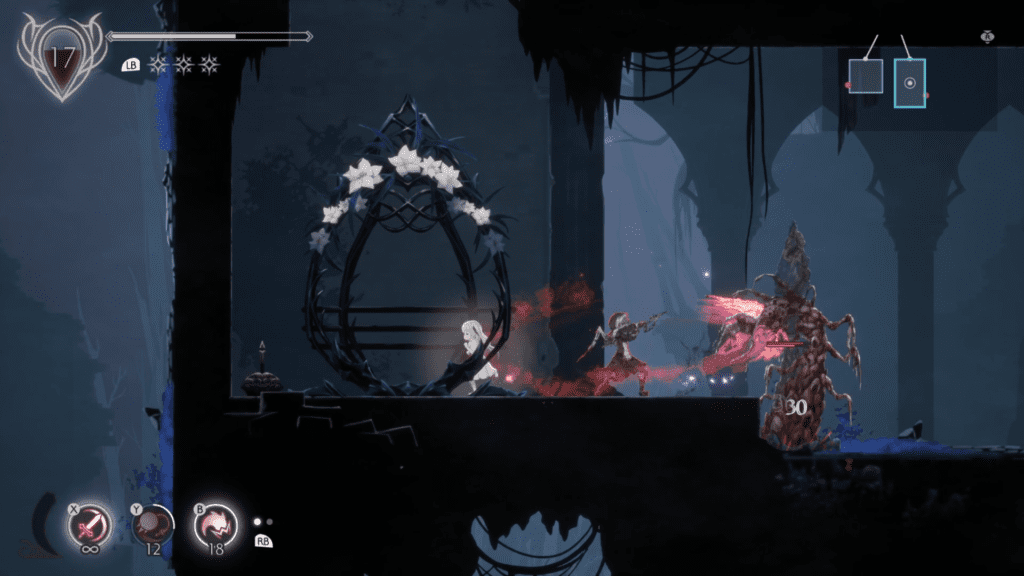While a decent action-adventure game is a dime a dozen, crafting a good “metroidvania” game is a lost art. The world itself is a giant puzzle, sort of like a compounded escape room – where after exhausting all other options through exploration, that one item, one upgrade, one ability is the key to unlocking a whole other world. Unfortunately, few games in this genre achieve that perfect balance of worldbuilding and challenge without being directly compared to the titles that gave this genre its name. With that said, Ender Lilies: Quietus of the Knights aims to set itself apart from its contemporaries.
Ender Lilies core strength lies in that it doesn’t try to lean in too hard on “metroidvania” classification. Granted, its structure is undoubtedly similar, but its gameplay is more akin to that of a souls-like. Even elements of the Dark Souls games could be attributed to the aforementioned genre – and in reality, Ender Lilies isn’t doing anything new or unique. Rather, it finds itself in a symbiotic relationship with the series that it borrows from and does it damn well.

Beware of the Rainfall
Amongst the dilapidated halls of a decaying temple, a lone spirit weaves through the overgrowth to find a sullied alter. Sleeping atop the platform lies a maiden emitting a consecrated glow. Awakened by the phantom, our protagonist finds herself in a dingy alcove of what was once a lustrous house of worship. Left without her memory, the apparition ushers her to take on the mantle of those who came before her, whose purpose is to heal broken land from a downpouring fetor that’s mutated her people.
Ender Lilies: Quietus of the Knights tells the story of Lily the last White Priestess: a young girl with the power to absorb the Blight, an affliction that transforms people into undead abominations. On her travels, she finds no survivors, but encounters powerful monstrosities of those who once were. By defeating these revenant malformations, more of the overarching story is revealed of how the Blighted Rains came to this nameless land, by way of personal recollection of each individual’s last days.
Little narrative is shared in between major encounters by way of characters communicating to each other. Instead, the diaries of prominent figures are scattered about each area, providing the motivations of these individuals: of how they battled the Blight, attempted to survive, or only wished to be with their loved ones in their final hours. There are no happy endings in Ender Lilies. The only incentive is to ensure that tragedy doesn’t befall yet another soul.

For You Are No Longer Alone…
By herself, Lily is more or less useless aside from being able to dodge oncoming deathblows. It is by way of her guardian spirits that she is able to defend herself through this accursed territory. While the game doesn’t explicitly divide them up, there are two categories of spirits to choose from: Main Skill Spirits that can be used an unlimited number of times, and Subskill Spirits that have more niche uses. You can assign up to three Spirits on an action palette, summoning an ally with the X, Y, and A buttons, and can swap between two palettes at any given time.
There’s nothing that prevents you from only using Main or Subskill Spirits, aside from possibly setting yourself up for failure. Main Skill Spirits like the sword-wielding Umbral Knight offer a flurry of short-range attacks at no cost. Meanwhile, subskill Spirits like the Dark Executioner are a bit more situational as it teleports behind an enemy doing moderate damage, has a limited number of uses, and a cooldown preventing you from spamming its abilities. It’s fine and dandy walking around with a barbarian spirit slugging around a giant mace, but sometimes I’d prefer to let my avian support spirit shoot enemies from afar.
Lily will also befriend Spirits that offer utility skills critical to traversing the overworld, such as smashing otherwise unbreakable pustulent barriers, breathing underwater, and using arcane arts to unlock sealed tombs. Largely standard elements in creating a metroidvania, although I do appreciate when the game subverts my expectations in how these abilities are sometimes used. I “know” that I will eventually gain an ability to reach tall plateaus. But instead of flat out giving me the ability to fly, which would pretty much trivialize platforming challenges, I’m given a grappling hook that launches me just high enough to where I need to go.

…Walk With Me In Hell
Combat is brutal. There’s no mincing words about it. Lily is one of the most “squishy” characters I’ve controlled as Ender Lilies offers little options in defending yourself. The only assured improvements you’ll see when you level up is an increase of damage output. Maximum health is increased by finding little trinkets sprawled across the hellscape that will raise your hit points in increments of five (or twenty if you’re really lucky). Emphasis is placed on your ability to either dodge or deflect oncoming attacks with really small execution windows. Your only method of increasing your defense modifier is by use of special relics, although there are more practical artifacts competing for your limited accessory slots.
You will find that death is a welcomed friend, as it will introduce itself over and over again. Lily, maybe, can stand three solid hits from a boss encounter before being whisked back to a save point. Your saving grace is your finite number of prayers you can use between rest stops. The system is reminiscent of the Estus Flask mechanic in the Dark Souls games, although Ender Lilies is far more stingy in giving more uses than what you start out with.
All of these factors present a very demanding experience. As you approach the late game, bosses are stacked with gratuitous amounts of hit points that you meagerly chip away at while they throw these five-frame invulnerable attacks that cover half the screen and deal 60-percent damage. As with other Souls-likes, its a process of identifying telegraphed moves, reacting, and whiff-punishing. But what makes me appreciate Ender Lilies: Quietus of the Knights even more is that every encounter encourages a different set of skills and relics, making me feel vulnerable at the start of each battle, and accomplished upon my victory.

Setting New Expectations
While I may be in the minority, Ender Lilies: Quietus of the Knights has effectively usurped the likes of Hollow Knight and Ori and the Blind Forest as my favorite in the genre. Again, it’s not anything groundbreaking, it just dances with perfection. The hardship being conveyed to the player is amplified by a mournful and eclectic soundtrack it accompanies. A special level of detail is put in the landscapes and character models, especially our very own Lily, whose alabaster hair and skin grow darker and more withered with each soul she purifies. Innocence is tarnished and stolen away and replaced with the burden of sacrifice.
Ender Lilies is a game that makes you hope and yearn for a happy ending that never quite presents itself. The uneasiness lingering long after the controller down is put down, pulling at the heartstrings as you encumber yourself with the Blight once more.
The full version of Ender Lilies: Quietus of the Knights is available on Steam and Nintendo Switch June 21.


